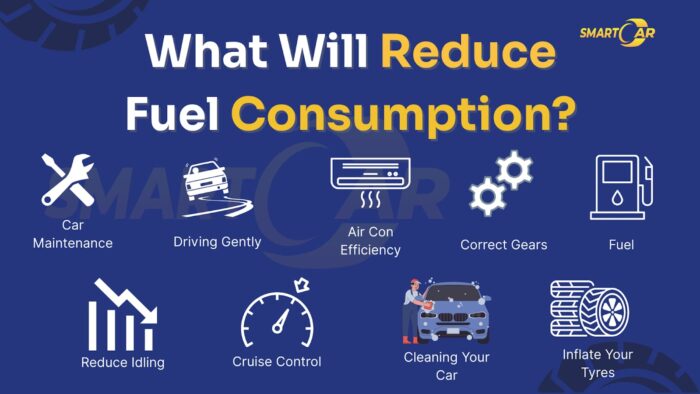Fuel consumption increases significantly during hard acceleration, excessive speeding, prolonged idling, and when carrying heavy loads. These conditions place added strain on your engine, causing it to burn more fuel than usual. Whether you’re aiming to cut down on fuel costs or reduce your environmental impact, it’s essential to understand what factors lead to higher fuel usage.
You can also use a VIN check to access your vehicle’s full history by VIN number, which may provide insights into any past issues affecting its fuel efficiency.
Now, let’s break down the main causes of increased fuel consumption.
What is Fuel Consumption?
Fuel consumption refers to how much fuel, be it diesel or petrol is consumed by the vehicle. It’s typically measured in Miles per Gallon (MPG), which tells you how many miles a car can travel per gallon of fuel. While manufacturers provide estimated MPG ratings, real-world usage often varies based on driving habits and conditions.
According to 2024 data from Nimble Fins, the UK average is 38.8 MPG. Petrol cars average 36 MPG, diesel cars 43 MPG, hybrids 53 MPG, and electric vehicles are most efficient with 123 MPGe (Miles per Gallon equivalent).
When Is Fuel Consumption at Its Highest?

Fuel consumption is at its highest level during certain specific conditions, like driving too fast and driving habits that could strain the engine and reduce fuel efficiency. These include:
- Aggressive Driving
Rapid acceleration, speeding, sudden braking, or driving too slow, all of a sudden, will make the engine work hard, which could increase the fuel consumption to get the desired speed quickly.
- Rough Acceleration
Hard acceleration could make the engine work even harder than usual, which means that the fuel consumption will be a lot since it requires too much work in a short amount of time.
- Driving Too Fast
When you drive too fast, it leads the engine to maximize its capacity to overcome the wind resistance, which causes more fuel consumption.
- Long Period of Idling
Idling wastes a significant amount of fuel while going nowhere. Whether waiting in traffic or parked with the engine running, fuel is consumed without movement.
- Carrying a Heavy Load
When the vehicle carries a heavy load (which might be more than what it is intended to carry), either on the roof or in the vehicle, it will cause extra fuel consumption because it increases engine strain. More power is needed, leading to higher fuel consumption, especially when towing or fully loaded.
- AC Usage
A long period of air conditioning usage could lead to extra fuel consumption because it puts extra loads on the engine.
How to Calculate Fuel Consumption
Understanding your vehicle’s fuel consumption is important for weekly fuel budgeting and assessing its efficiency. The standard metric used is liters per 100 kilometers (L/100 km), which indicates how many liters of fuel your vehicle uses to travel 100 kilometers.
Step-by-Step Calculation
To determine your vehicle’s fuel consumption, follow these steps:
- Fill Up Your Tank: Start with a full tank of fuel.
- Record the Odometer Reading: Note the current kilometer reading on your vehicle’s odometer.
- Drive as Usual: Use your vehicle normally until it’s time to refuel.
- Refuel: Fill up your tank again and note the number of liters it took to fill.
- Record the New Odometer Reading: Note the new kilometer reading.
- Calculate the Distance Traveled: Subtract the initial odometer reading from the new reading to find the distance traveled.
- Apply the Formula:
Tips on How to Minimize Fuel Consumption
Minimizing fuel consumption is important; to do that, you can reduce the air conditioner usage slowly, drive carefully, and carry the load according to the car’s size. Here are the things you need to know to minimize fuel consumption so it’s not hurting your wallet.
Regularly Maintain Your Car
Make sure to follow your car’s regular maintenance schedule to keep up with parts like the engine, tires, and filters stay in top shape, to keep the performance in shape.
Minimize AC Usage
Air conditioning puts extra work on the engine and raises fuel use. Once the cabin cools, reduce the fan speed, adjust the temp, or switch it off to save energy.
Drive Carefully
Try to brake and accelerate gently to get you the best MPG or miles per gallon by keeping the engine RPM low and using minimal fuel. It is better to avoid idling or speeding for a long time, as both waste more fuel due to air and tire wear
Use the Right Gears
Make sure to use the right gears to maximize the fuel efficiency. Protip: choose the gear that suits the car (not too low nor too high for the current terrain and speed). For a vehicle that uses petrol, the most economical range is between 1500 and 2500 RPM. For diesel vehicles, the range is usually between 1300 and 2000 RPM.
Don’t Overload Your Fuel Tank
Pay attention to when you will fill up your tank again after the last time. If the fuel is full, your tank will be full; in that way, it could contribute to the extra weight your vehicles carry around. On the other hand, driving with too low fuel could damage the vehicle’s vital components.
Conclusion
If you own a car or plan to own one, paying attention to its mileage is crucial. You might not realize that you are maximizing fuel consumption by driving recklessly or simply setting the air conditioner too low and too often. Protect your wallet and your car by fixing your driving style, paying more attention to how you use the aircon, and regularly maintaining your car.
Frequently Asked Questions
What is the best speed to save petrol?
The most fuel-efficient speed for most vehicles is between 45 and 60 mph. Driving steadily within this range reduces engine workload and wind resistance, helping you get more miles per gallon and save on petrol costs long-term.
At what speed does a car consume more fuel?
Fuel consumption increases noticeably once you exceed 60 mph. Higher speeds create more air resistance and require the engine to work harder, leading to greater fuel usage. The faster you drive beyond this point, the less efficient your car becomes.
What speed should I drive to save fuel?
To save fuel, drive smoothly at consistent speeds between 50 and 60 mph where possible. Avoid rapid acceleration and heavy braking. Keeping a steady pace helps your engine run efficiently and significantly improves overall fuel economy during your journey.


